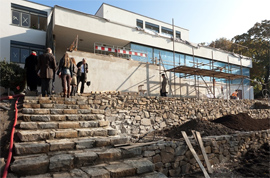
Repair of the Tugendhat villa is coming to an end, the villa will open in March
 |
| photo: David Židlický |
According to Macek, it will be high-quality stone from the same quarry from which the builders of the villa brought the original stone. The only difference is that the slabs are cut in a different direction to the layers of sediment in the stone than they were originally.
The councillors also approved a contract to create a publication about the villa and its reconstruction, which will be produced by photographer David Židlický. The process of heritage restoration is being documented, and photographs from each month of work are published on the villa's official website. "The publication will be released in an edition of 500 copies, so that it will be available at the opening of the villa," added Macek.
The site is scheduled to open to tourists and modern architecture enthusiasts on March 3rd. In January, the villa's managers are expected to launch a reservation system. Guests are promised new features - a shop for specialized literature, a research area, and new visitor routes, for example, in the technical floor of the building.
The villa was built according to the plans of the famous architect Ludwig Mies van der Rohe on a plot in Brno's Černá Pole from June 1929. The Tugendhat family moved in in December 1930. They only enjoyed the house for eight years. Fearing the Nazis, they emigrated. The current heritage restoration of the villa represents the largest construction intervention in its history. Builders, under the supervision of heritage experts, are working to retain as much of the original materials as possible and are using the same technologies. During the construction in recent months, research efforts have continued, which have resulted in the discovery of a part of the original semicircular makasar wall that defined the dining room in the villa. Brno art historian Miroslav Ambroz discovered it in the cafeteria of the law faculty.
The English translation is powered by AI tool. Switch to Czech to view the original text source.
0 comments
add comment










